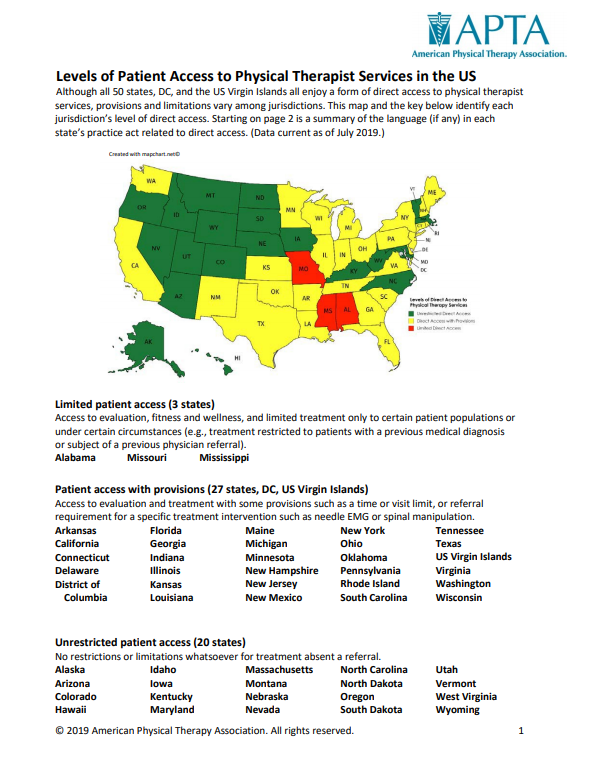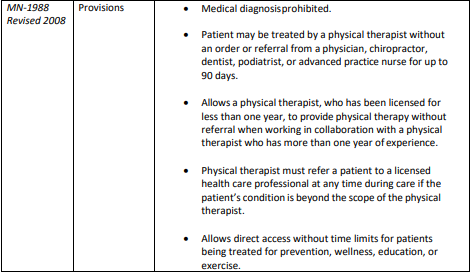In this blog I will be discussing all patient questions related to direct access to physical therapy (PT). Direct access to physical therapy can be defined as the ability of a patient to legally and safely see a physical therapist for evaluation and treatment without first seeing a physician and receiving a physical therapy order or referral.
Why is direct access to physical therapy a good thing?
Saves time
Sometimes it can take weeks to get in and see your primary care physician. Even after getting referred to physical therapy, it’s usually left up to the patient to call a physical therapy clinic to set up an appointment. Sometimes your doctor will send an order to a specific PT clinic and you will have to wait for that clinic to contact you to set up your appointment.
By going directly to the physical therapist, you can skip this entire process and save time without delaying your care.
Saves money
It costs hundreds of dollars or more to see a physician. More and more patients now have high deductible insurance plans and can end up paying the majority of the physician cost plus copays. Most patients who see a physician with complaints of pain with activities or loss of function are ultimately referred to physical therapy.
By going directly to the physical therapist, you can skip these extra costs.
Reduces stress
Even after arriving to your physical therapy appointment, it can be very common that the PT clinic has still not received your physical therapy order. For many patients, the health care system can be difficult to navigate which causes unnecessary stress and anxiety. Sadly, some patients get lost in the mix and never receive the care they need.
Knowing that you can go directly to your physical therapist can eliminate stress and worry.
What direct access restrictions do patients need to be aware of?
State restrictions
Over time, direct access to physical therapy has improved significantly, but there are still restrictions in some states for patients. The best place to learn more about direct access in your state is through the resources published by the American Physical Therapy Association (APTA).
As an example, here is a map showing varying levels of direct access in each state from the APTA direct access resources.

If you scroll down on the same APTA direct access resource you can read the specifics for each state. As an example, we can preview provisions for the state of Minnesota:

It’s helpful as a patient to be aware of these guidelines so you can fully leverage the benefits of direct access, but a licensed physical therapist will be the best resource to help guide you through the process. It is not the responsibility of a patient to know when to check in with a physician.
Insurance restrictions
Even if there are no legal restrictions for direct access to physical therapy in your state, there may still be insurance restrictions. You should contact your health insurance provider by calling the phone number on the back of your insurance card to find out if a referral is required prior to reimbursement of physical therapy services.
You can also skip the hassle of insurance all together since platforms such as Tagojo.com provide access to cash pay physical therapy at rates as low as 40-50% of the cost of insurance based physical therapy.
What problems are appropriate for direct access to physical therapy services?
Pain with exercise or movements
This includes pain in muscles, joints, and ligaments during daily activities or exercise. The most common areas of pain that can be helped with physical therapy include shoulder pain, neck pain, low back pain, elbow pain, wrist/hand pain, hip pain, knee pain, and foot/ankle pain.
Difficulty with activities
This includes things such as decreased endurance with walking or going up stairs, feeling off balance, difficulty dressing or performing daily activities. Sometimes patients can present with chronic conditions that have already been accurately diagnosed and managed by a physician that could benefit from direct access to physical therapy to improve residual functional impairments.
Preventative medicine
This includes screening to identify and address mild impairments before they lead to pain or illness. Many patients also receive preventative medicine to maintain an existing level of function.
Improving performance
This includes things such as improved performance in sports and hobbies such as soccer, football, cross country, gymnastics, or competitive physical events.
How will a physical therapist treat a problem without a specific diagnosis from the doctor?
A specific medical diagnosis is not necessary in most cases. Most of the time if your problem is related to any of the above 4 things, physical therapy will help without a specific medical diagnosis. Physical therapists are trained to perform screenings to determine if your problem can be helped by physical therapy or will require further diagnostic work up from your physician.
What problems are not appropriate for direct access to physical therapy services?
Post-operative care
Physical therapy commonly addresses post-operative conditions, but it is important to have a referral from your surgeon so your physical therapist can be aware of any protocols, restrictions, or precautions before starting treatment.
Emergency care
High level traumas such as car accident, significant fall, or other types of injuries should be assessed by a physician prior to starting physical therapy. Acute medical episodes such as suspected heart attack, stroke, diabetic emergency, shock, etc. are also not appropriate for physical therapy and require immediate medical attention from a physician.
Medical red flags
The following signs and symptoms require a visit with a physician prior to seeing a physical therapist: shortness of breath, acute chest pain, unexplained weight loss, night pain not relieved by rest, fever with chills, possible infection, loss of control of bowel or bladder
This is not an exhaustive list of all possible red flags. You can learn more by googling consulting with your doctor.
What should I know about physical therapy before using direct access?
The more you know and understand about what happens in physical therapy, the better you can recognize if utilizing direct access to physical therapy would be best for your problem. Let’s go through what a physical therapist will cover on a typical evaluation so you can determine if it sounds right for your situation.
History/Intake
A physical therapist will get a detailed intake of your problem history, medical history, and goals for physical therapy. This gives them necessary information to provide appropriate screening along with personalized assessments and recommendations to help you reach your goals.
Assessment
A physical therapist will assess your body structures, body functions, activities/participation in society, and environment.
Body structures include the physical things about your body that your physical therapist can observe on your body or assess from existing results of diagnostic images such as x-ray, ultrasound, MRI, or CT scan. If you feel these results would be helpful to your Physical Therapist then you should bring them to your first visit.
Body functions include how the physical parts of your body work. These include things such as muscle strength, power, endurance, range of motion, flexibility, agility, coordination, reflexes, heart rate, blood pressure, respiration, sleep hygiene, basic mental functions, etc.
Activities and participation relate to activities such as learning, applying knowledge, self-care, household tasks, moving around in your environment, work tasks, school tasks, and participation in social activities and events.
The environment includes factors such as the degree of a family support system, attitudes of people in your life, access to different assistive products and technology, and attributes of your physical environment.
Identification of functional deficits
Through the above assessment, they may find impairments of body structures, impairments of body functions, activity limitations, participation restrictions, or environmental barriers that hinder your ability to function and reach your goals.
Treatment and monitoring of functional deficits
They can address these deficits by administering interventions such as exercise or education while closely monitoring progress over time.
How do I find a good Physical Therapist when using direct access?
Use a search engine
Try googling “physical therapists near me” to find PTs that specialize in an area similar to your problem or interests. Google or Yelp ratings and reviews can often offer insight on different PTs near you. You can also check the websites of different clinics in your area to see if they provide any information on their staff physical therapists.
Check out Tagojo marketplace for one stop shopping
Tagojo offers a marketplace to browse physical therapists profiles in your area. It is slowly becoming a centralized platform where you find a physical therapist that has skills and interests related to your problem. Scheduling, payment, and communication can be done right on the platform which is the easiest way to leverage direct access to physical therapists. Tagojo is constantly adding new support for ranking physical therapists and allowing patients to manage and track their functional progress over time.
Where can I see a Physical Therapist using direct access?
Local clinics
Traditional physical therapy has mostly been done in a clinic setting. By using Google, you can find physical therapy clinics in your area.
In the community
On Tagojo, a physical therapist will meet you in your home or one of their pre-vetted meeting locations which includes gyms, parks, ball fields, workplaces, etc. Tagojo is offering innovative access models in convenient environments that are tailored to a patient’s specific goals or problems.